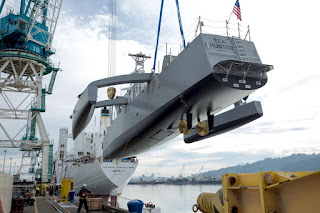Ghost Ships

DARPA Bots At Sea The US Defense Department's Advanced Research Projects Agency - DARPA - has developed a "ghost" ship. It's called SEA Hunter and has an all-robotic crew. No humans allowed on board. It's the first prototype of an autonomous, robotic sub hunting ship. It's been christened and is now being tested, deployed and developed by the Office of Naval Research. It gives new meaning to Wagner's Opera "The Flying Dutchman". SEA Hunter's Awesome Technology Robo ship uses a 5th generation medium frequency sonar system mounted on the hull. It conducts both active and passive sonar passes. DARPA is also working on the development of nonconventional sensor technology to further enable the vessel to precisely spot and track enemy subs, mines and vessels on the high seas. Revolutionary Prototype DARPA believes SEA Hunter is a revolutionary prototype vehicle that could ultimately lead to a new class of ocean going vess





